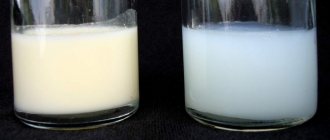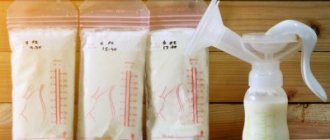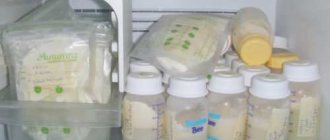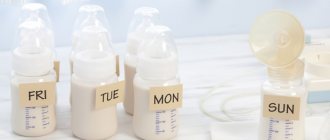Difficulties with breastfeeding may occur if
- you need to go to work, study or run errands;
- the child is premature or has diseases that prevent sucking;
- the breast is hard and full - it is difficult for the baby to suck;
- it hurts to feed because of cracked nipples;
- the mammary gland is inflamed (mastitis);
- you have been temporarily prescribed the necessary medications; they are contraindicated while breastfeeding;
In all these cases, pumping helps maintain or establish breastfeeding.
Important aspects of breastfeeding: everything about expressing milk
When is it necessary to express breast milk?
The need to express milk can arise for many reasons: from medical indications to everyday situations. Strict recommendations related to the condition of the child or the health of the mother may limit the possibility of breastfeeding the baby. For example, you cannot put a baby to the breast if the mother is taking medications that are incompatible with breastfeeding. It is important to know that if for some reason a mother is temporarily unable to breastfeed her baby, but would like to preserve milk in the future, she needs to start expressing it regularly to maintain lactation.
Other situations in which milk expression is required are related to the physiological characteristics of the mother’s body. At night, a nursing woman actively produces the hormone prolactin, which is responsible for the creation of breast milk. Therefore, the mother may often feel hot flashes. If the baby is sleeping too soundly, then the milk must be expressed. Taking breaks at night is not recommended - milk should be expressed every 3-4 hours. This rule should also be followed when mother and child are separated for several days.
In a situation where a mother needs to go to work or leave for several hours, pumping allows her to prepare the necessary supply of milk for her baby.
How much milk needs to be expressed so that the mother can arrange a meeting with friends and not worry that the baby will remain hungry?
In the first month of life, 100-150 ml are needed for one feeding, but the older the child, the more milk is needed. Of course, it is not always possible to create such a supply of milk at one time, so experts advise expressing in small portions several times during the day.
What is the best way to express milk?
Before the advent of modern breast pumps, it was believed that manual expression was more natural and, therefore, preferable. Now experts do not see any special advantages, since new breast pumps completely imitate the sucking movements of a baby. The exception is situations when it is necessary to strain a stagnant lobule of milk in the case of lactostasis, when it is more convenient and effective to feel, massage the dense lobule and express the breast manually. Manual expression is sometimes more convenient in the case of cracked nipples, when a woman may experience discomfort from the rarefied air that occurs when expressing with a breast pump.
During sucking, the baby makes two types of movements: peristaltic, when he contracts the muscles of the mouth and massages the breast, pumping milk, and vacuum, during which the milk, previously collected in the lobes, is suctioned. These two types of movements are perfectly reproduced by modern electronic breast pumps, such as PhilipsAvent, making the pumping process as close to physiological as possible.
What should a mother follow when choosing a pumping method?
There is no general opinion on this issue, everything is individual. But with any type of pumping, it is important to have good technique to avoid possible injuries. This is especially necessary when using a manual breast pump and manual expression. During the process, your arms may get tired and your back may become numb, since the woman must sit almost at a right angle to the container. Electric breast pumps solve this problem. Models like the Philips Avent SCF332 electronic breast pump allow you to express in a comfortable position - you no longer need to lean forward to get milk into the bottle, you can sit in a chair and spend time reading or watching your favorite movie.
What should you pay attention to when choosing a breast pump?
At first glance, all breast pumps seem beautiful, bright and light. However, when choosing a product, you should focus on the composition of the material from which the breast pump is made, the characteristics and reviews of more experienced mothers, and advanced mothers can even study clinical studies. It is best for the breast pump to be made of lightweight plastic - polypropylene. This is a non-toxic material that does not deform when exposed to high temperatures and is safe for children. It is also worth paying attention to the additional accessories included in the kit: whether they satisfy all your needs or will require extra expenses. For example, a pumping container may come with a nipple that you can immediately attach and give your baby milk without pouring it into another bottle.
Should I give my baby a bottle while breastfeeding?
There is an opinion that using a pacifier or bottle can disrupt the natural feeding rhythm and the baby will refuse breastfeeding. However, research does not confirm this. If the mother breastfeeds correctly and is well acquainted with the technique of breastfeeding on demand, the child’s attitude towards this process will remain unchanged. It is important that feeding the baby from a bottle also corresponds to the physiology of sucking.
Also today, mothers have access to interesting new developments among bottles. The shape of the physiological nipple closely follows the shape of the female nipple. Such imitation further contributes to ensuring that the child does not wean himself off the breast. For example, Philips Avent Natural teats have a reduced opening to ensure a very slow flow of milk. This feature, as well as the texture of the nipple, which resembles a nipple, makes feeding as similar as possible to breastfeeding.
What about pacifiers: are there any consequences from using them?
If the need arises, do not be afraid to use pacifiers. When lactation is just established, the mother can put the baby to the breast at his every request. But in some cases, the child may worry not because of hunger, but due to an unsatisfied sucking reflex. In this case, as well as if the baby is hyperexcitable, you can offer him a pacifier, the use of which will not in any way affect successful breastfeeding.
How often should I pump?
To maintain or increase lactation, express regularly. The more often you empty your breasts, the more milk you will produce. It is formed “on request”. This is regulated by 2 hormones: prolactin and oxytocin.
The first one “releases the plan” to the mammary gland for milk, depending on how much was needed last time. Oxytocin allows stored milk to flow from the breast in response to nipple traction - this is called the oxytocin reflex.
How to signal to your body how much nutrition you need to create for your child?
If you don't have enough milk, pump every hour for the first few days. Then you need to express as often as the baby would like to eat: usually every 2-3 hours. This regimen is also suitable for maintaining lactation. At night you can take a break for 4-6 hours.
How long can I use expressed milk? Look at the table. It refers to milk collected in a sterile container. Write the date of collection on the container.
Breastfeeding successfully, or When to pump.
04.07.2017
.
Ekaterina Ruchkina, obstetrician-gynecologist, breastfeeding specialist: “With properly established breastfeeding, a woman does not need any additional pumping.”
“Be sure to express after every feeding!” doctors in the maternity hospital instruct young mothers. “If you don’t pump, the baby won’t have enough milk,” grandmothers, aunties and other older relatives echo. Having listened to such advice, the woman, in addition to all the existing troubles, takes on one more additional responsibility, buys an expensive breast pump and spends rare minutes of free time on a new and not at all exciting activity called “pumping”.
Is it really mandatory and necessary for all new mothers? Obstetrician-gynecologist and lactation consultant Ekaterina Nikolaevna Ruchkina talks about in which cases pumping really saves, and in which it can harm.
– Please tell me, is pumping really the key to successful breastfeeding, and is it necessary for all breastfeeding women?
- Of course not. First of all, I will say that lactation is not a disease, it is a normal and natural state for every woman who has given birth to a child. This process should be easy and comfortable for both the baby and his mother. Ideally, when a baby is born, there should be on-demand feeding, meaning that the mother will attach the baby to the breast for as long as he needs. Then the milk will be produced exactly as much as her baby needs. Also, the mother can apply additionally when too much milk comes in and the breasts begin to swell. In the postpartum period or if the baby, for example, sucks sluggishly and the breast does not release, the mother can before feeding until she feels light, so that she is comfortable. This will help her endure until the baby becomes active and empties the breast well.
If all these conditions are met, then the mother does not need to express “to the last drop” after feedings. The mammary gland works in such a way that there is no “last drop”, and milk is produced constantly. And if the breasts are additionally stimulated by pumping after each feeding, then the milk production will be too large and, of course, unnecessary. In this way, the mother will simply fall into a vicious circle and instead of resting and spending time with the child, she will endlessly strain vitamins and nutrients from herself.
– What to do in a situation where there are no pathologies, but the mother and baby are separated in the maternity hospital, and not in a shared ward? Is it necessary to pump additionally, in addition to feeding once every 3 hours?
“It is in this case that a young mother may need pumping, as they were required in those days when maternity hospitals did not allow for shared stays. If a woman is not with her child, she should imitate the state in which they would be together, that is, imitate the demand for milk. To ensure its normal production, in a volume sufficient for the baby, the mother needs to express from 8 to 12 times a day, including at night.
Also, pumping in the postpartum period may be required if a woman was unable to attach the baby correctly or had engorgement of the breast or nipple, which can make feeding very painful. In such situations, a woman is recommended to express her breasts literally drop by drop, gently pressing on the breasts every 1.5-3.5 hours to relieve excess tension and swelling. She can also do this before breastfeeding to also relieve soreness and relax the breasts. This is usually required within the first two days, the tension in the chest disappears and the breasts become soft.
– In what situations is pumping necessary and even irreplaceable?
– There are quite a lot of such cases. For example, pumping is a salvation when mother and child are separated or there is some pathology on the part of the mother or child, and feeding cannot take place. Here the woman must “trick her head” and create a request for milk, imitating the baby’s regular attachment to the breast. As in the previous case, you first need to express colostrum a few milliliters at least 8-10 times a day, and after the milk arrives, “work for volume”, making sure that the expressed milk corresponds to the volume of milk needed by this baby.
– Can pumping also be necessary for lactostasis? Are there any special features of this procedure for blocked ducts?
– If a woman experiences lactostasis, then it is best to contact a breastfeeding specialist , since in this situation the consultant uses targeted expression of the diseased duct to prevent the creation of a breeding ground in it for the proliferation of bacteria and aggravation of inflammation. The consultant will teach the mother how to pump correctly, and she should work specifically on the painful area of the breast. You need to express methodically, every 3 hours, without being too zealous and without making a “chop” out of your breasts.
– Is it possible to increase milk production by pumping? How to do this correctly?
– If a mother has little milk, she needs, again, to “trick” her head and imitate an increased demand for milk. That is, in between feedings, you should create regular stimulation of the nipples, which increases the production of the hormone prolactin, which is responsible for the production of milk. There is no need to focus specifically on expressing the milk; you need to massage the areola. If at the same time milk begins to be released, there is nothing to worry about, you can collect it and give it to the baby when he needs it.
– What is the best way to pump if the need arises? And should women immediately take a breast pump with them to the maternity hospital?
– If pumping is necessary for a long time, in situations where the baby is low weight or in other cases of separation from the mother, of course it will be easier for the mother to use a breast pump. But when pumping is necessary from time to time: for example, when the mother needs to go somewhere or work with a diseased duct, manual pumping is sufficient. With lactostasis, you generally need to express exclusively with your hands.
When it comes to buying a breast pump, I personally don’t recommend anyone purchase one ahead of time. Why spend money and set yourself up for future problems, because if necessary, you can buy everything literally within a few minutes. Today, breast pumps are sold in all pharmacies, and relatives will be able to give you one in the shortest possible time. In addition, now all maternity hospitals have specialized clinical breast pumps that mothers can use if necessary.
Urgent call for a breastfeeding specialist
via the hotline of the MOTHER'S MILK Center: 99-76-60 more details
Lactostasis, mastitis, breastfeeding consultants with medical education, AKEV consultants in Ryazan, AKEV consultants in Ryazan.
Calling a breastfeeding consultant Feeding clothes, slings
Did you like the article? 114
Share
How long can expressed breast milk be stored and how to store it correctly
— at room temperature for 4 hours; — in the refrigerator at a temperature of 4 ± 2°C for no more than 24 hours; — in the freezer at -18°C for 3–12 months. (optimally no more than 3 months).
Tiunova Elena
K.M.N., pediatrician of the highest category, nutritionist
“Pour out the breast milk after pumping if you were prescribed medications during breastfeeding that are contraindicated for breastfeeding.”
If you need to make your breasts softer for comfortable feeding, then you decide how much to express. How to start the process?
Why do you need to pump?
With normal lactation and proper organization of feeding the baby, there is no need to express. Mothers and grandmothers may strongly advise expressing the remaining milk after each feeding, but these are just relics of the past. The recommendations of modern pediatricians and breastfeeding experts are the opposite: normally, the baby suckles as much as he needs, and the same amount of milk is produced for the next feeding. The on-demand feeding regimen, which is now recommended for mothers, assumes that the baby will receive its portion of milk.
However, pumping becomes necessary in some situations:
- when the child is weak and finds it difficult to suck milk from the breast (there is a need to supplement the baby with expressed milk from a bottle);
- in case of lactostasis (milk stagnation) in a nursing mother;
- with insufficient production of breast milk, lactation crisis;
- if there is an excess of breast milk, the baby begins to choke and therefore cannot suckle;
- if the mother is taking medications that prohibit breastfeeding, but wants to resume lactation after completion of treatment;
- when mom needs to go somewhere or goes to work;
- if a supply of breast milk is required.
When to pump?
- Pumping causes the glands to work more actively and produce more milk. So you shouldn't abuse it.
- If the mother is going to go somewhere or go to work, it is recommended to start pumping in advance so that the mammary glands “get used” to the new regime and the required volumes. If possible, at the time of separation from the baby, if milk flow occurs, it is also useful to express in order to reduce the risk of milk stagnation.
- If you have excess milk, it is recommended to express a little before feeding. This will reduce the volume of liquid milk (“foremilk”), so the baby will stop choking and will immediately latch onto the breast.
- If you are concerned about lactostasis, you need to express milk until the symptoms are relieved - pain and swelling are relieved. Then the mother should put the baby to her breast more often to prevent further stagnation of milk.
- If milk production is insufficient, you should express strictly after feeding - this stimulates the functioning of the glands.
- When taking medications, pumping should be done in the usual feeding mode - at the moments when the milk flows in.
- It is convenient to store milk when the child misses a feeding - for example, sleeps longer than usual (should I wake the child for feeding?).
- If milk comes in when parting with your baby, it is useful to express it to reduce the risk of developing lactostasis.
How to pump?
You can use breast pumps, which are manual or electric, or express your breasts by hand. The devices are excellent at collecting “front” milk, but they don’t always cope with “hind” milk. It is thicker, which makes it more difficult to express.
The manual method is much more efficient. Place your thumb and forefinger on the opposite edges of the areola, spread them with the skin and move them inside the breast, stimulating the milk ducts, not the nipple. With your second hand you can simultaneously knead the base of your chest. After several presses, each time move your fingers around the areola to eventually cover all the lobes of the mammary gland. Do not press hard or rub the skin. If the procedure is performed correctly, there should be no pain.
For engorged breasts and hard nipples, when pain occurs when expressing, it is recommended to use the “warm bottle” method. You will need a bottle with a wide neck that will easily fit around the nipple and areola. You need to pour boiling water into the container. Then wait a little and apply the neck to the area around the nipple. As the bottle cools, it will draw in the nipple and the milk will begin to flow out.
The warm bottle method is convenient, but does not provide complete emptying. Therefore, it is better to complete the procedure with regular manual expression. The breasts will already be softened, so there will be no pain.
We also read:
- Learning to express breasts with your hands
- Choosing a breast pump and learning how to express breasts correctly
How to stock up?
A nursing mother should make sure that she always has at least a modest supply of expressed milk. This will help out in case of an urgent departure, illness and in other unforeseen situations when you have to temporarily part with the baby.
At room temperature up to 25°, breast milk is stored for 3 to 6 hours, in the refrigerator for 24 hours, and in the freezer longer for 1 to 3 months. Therefore, to create a long-term supply, it should be frozen in special containers or bags. Before sending for storage, breast milk should be kept for about half an hour in a closed container so that it retains all its valuable qualities. Each portion of milk must be packaged separately, indicating the date of expression - in this case you can control its freshness.
Read also: All about proper storage of expressed breast milk
How to stimulate milk flow faster without a baby?
- make yourself comfortable;
- think about how you are currently caring for your baby;
- while pumping, look at him or hold his clothes in front of you;
- drink a warm drink (not coffee) or take a warm shower;
- massage your nipples by rolling them between your thumb and forefinger, or gently massage your breasts;
- if you have an assistant, ask her to give you a back massage. It is carried out like this: you sit at the table and lean forward, leaning on your elbows. You lower your head. Your assistant clenches her hands into fists, leaving only her thumbs. She spends 2-3 minutes running her thumbs on either side of the spine. The movement is made from top to bottom from the neck to the shoulder blades.
If you're upset that you now have to pump, find support. This will be someone who will listen and encourage you. An upset state also interferes with the free flow of milk: take care of your good mood. In any case, you do everything in your power for the baby.
So, you felt a rush of milk. Now start expressing milk into a bottle. Follow the rules for expressing milk, and you won’t get hurt. With mastitis, unpleasant sensations are possible that are associated with the inflammation itself.
It is important!
Expressing breast milk by hand gives about the same results as using a breast pump. Which is better depends on your feelings and convenience for you.
What to do if there is very little milk
If milk comes in insufficient quantities, you can make it come in using the following recommendations::
- Take a warm shower;
- Drink hot tea with added cow's milk;
- Place a terry towel soaked in water at 37 degrees on your chest;
- Relax, put your baby next to you and think only about good things.
- Carefully ensure that the baby receives the so-called “hind” milk, because I drank everything from my chest, without a trace. If this cannot be achieved, then in such cases you need to use a breast pump.
Thus, it is better to prepare 15 minutes before the expected feeding.
You can ask any questions on this topic to a lactation consultant; phone numbers for such services can be easily found on the Internet. Even if you have completely lost milk, there is still a chance to resume lactation.
How to express milk by hand
So, you washed your hands with soap and feel a rush. What's next:
- Sit comfortably, bring the jar closer to your chest.
- Place your thumb on top of your chest, directly above the areola.
- The index finger and the other fingers behind it are under the areola, opposite the thumb.
- Rolling your thumb and forefinger along the surface of your chest, lightly press on your chest and immediately release the pressure. You cannot rub the skin or slide on it. Press gently on your breasts: too much effort will prevent milk from coming out at all.
- Press and release. The milk comes out gradually: be patient and confident.
- Change the position of your fingers. Now place them on the sides of the areola opposite each other.
- Press and release again.
- After 5-6 minutes, when the milk flow slows down, move to the other breast.
- When you have emptied the second breast, go back to the first or now try expressing from both at once.
- If you express very little milk, you can reduce the procedure time, but do it more often.
Preparation and process
Photo source: shutterstock.com
Preparing for this process only takes a few minutes. It is necessary to sterilize the container, wash your hands or breast pump. Before pumping, it is better to take a hot shower or apply a heated towel to your breast, then the milk will come out easier. Breastfeeding experts always emphasize the importance of the mother’s psychological mood: when we think about the baby, milk flows under the influence of hormones. Therefore, at home you can sit next to your sleeping baby, and in any other place you can open his photo on your phone, and the milk will literally flow like a river.
Each mother chooses to express by hand or with a breast pump independently. It is worth trying both methods to decide which is more convenient and in which case the milk comes out easier. The manual expression technique is as follows:
- Massage your breasts a little, holding them from below with one hand and from above with the other. Move in a circular motion towards the nipple.
- Take the most comfortable position for you. Most often they express while sitting, bending forward slightly. When lying down or standing, milk flows worse.
- Four fingers of the hand should be under the breast, as if supporting it all, and the thumb should be above it, about three centimeters above the tip of the nipple.
- Use your thumb and forefinger to press down on your breasts and gently move from the ribs to the tip. Squeeze and release rhythmically in one area, and when the milk begins to flow less, move your hand to another lobule. Clockwise, you should go around the entire chest, straining each section. If everything is done correctly, your breasts will become noticeably softer.
- When one breast is empty, move on to the other. This is not at all as difficult as it might seem at first. Just don’t expect to squeeze out every last drop of milk, because it is produced even during the feeding process, and this is the illusion you create for your body.
It is believed that a breast pump, manual or mechanical, helps to significantly save time and effort. This modern device is really quite simple and easy to use. A manual one works quietly, but the hand can get tired from frequent pressing of the lever, while a mechanical one can be alarming with its noisy operation and high cost.
All parts must be sterilized before assembling the device and starting to use it. Please ensure that the breast pump nozzle is the appropriate size for your breast: the nipple should not be adjacent to the walls of the breast shield. The nozzle is suitable if the nipple moves back and forth under air pressure during operation of the device. To make the chest fit better to the perimeter of the funnel, you can moisten it with a damp cloth. Do a light self-massage and start working with the device (or just turn it on at a comfortable speed if the breast pump is automatic). It takes about 15 minutes to pump one breast using the device. Then you can proceed to the second.
Some mothers find breast pumps ineffective in the process of expressing milk. Manufacturers also note that milk can flow quite heavily if a vacuum has not been created between the funnel and the nipple, and also if the woman did not have a flow of milk at the time of using the device.
How to Express with a Breast Pump
Do you feel uncomfortable expressing with your hands? Use a breast pump:
- Make sure your breast pump is thoroughly washed and dried.
- Wash your hands with soap.
- Induce milk let-down using one of the methods described above.
- Place the breast into the breast pump funnel, with the nipple strictly in the center. Choose the size of the funnel according to your bust size.
- If it is a mechanical model, press down on the device that extracts the milk. In the electric model, select the desired operating mode: when you are not in pain and the milk is flowing. For optimal speed, start with the lowest power setting. Increase until the first signs of discomfort appear; after they appear, reduce the vacuum level by one notch.
- If the milk does not come out within 5 minutes, try again a little later.
- A breast pump should not be used for cracked nipples.
Expressing with a breast pump
Some women express their breasts using a breast pump. Most often, this procedure takes place in two stages, the first of which is still manual expression of breast milk. It must be said that when pumping breasts that are soft to the touch or are completely full, the technique does not work in all cases.
Now there are many varieties of this technique, but you need to select it for each person independently, relying on sensations. For example, some people prefer the electric option, while others may find it rough.
What is better to express: by hand or with a breast pump, Dr. Komarovsky:
Types of breast pumps, their advantages and disadvantages
They are:
- Manual mechanical ones are silent, but require skill. To create a vacuum that pumps out the milk, a piston, syringe or bulb is used.
- Electric ones will do everything for you, but they will make noise during the milk extraction process. Some models also have a mode that stimulates the tide. Powered by mains and batteries.
Learning to express milk takes patience and time. WHO recommends that all new mothers learn at least how to pump manually. This way you will ensure the best nutrition for your baby under any circumstances.
Why you might need to express your breasts
By expressing her breasts, a woman pursues certain goals. Depending on the initial situation and the expected result, breast stimulation can be performed regularly, with breaks for natural feeding, or once.
After childbirth
After a natural birth, the baby is placed at the breast. If for some reason this cannot be done, it is necessary to express the mammary glands within 4-6 hours.
If in the future the baby is with the mother, additional emptying of the breast is not required. It is necessary to continue nipple stimulation every 1-2 hours when the baby does not latch on or is temporarily bottle-fed.
Before or after feeding the baby
The balance of breast milk allows the baby not only to use it as food, but also to replenish the lack of fluid. Physiology provides that first, foremilk is released from the breast, which has a liquid consistency and allows the baby to drink. After this, the production of a fattier and more nutritious portion of milk begins.
If you pump before feeding for no reason, you can upset this balance, which will lead to disruption of the baby’s digestive tract. Pumping after breastfeeding leads to an increase in baby food volumes.
Stagnation of breast milk with lactostasis
With lactostasis, one of the ducts becomes blocked. This leads to the accumulation of biological fluid in the gland, the formation of a lump, swelling and pain. It is difficult for a child to cope with the problem on his own. Therefore, before latching the baby, a woman should knead the bump a little and express a portion of milk of 5-10 ml.
Creation of a milk bank
A home breast milk bank is created for the purpose of further supplementary feeding of the child. It is not recommended to pump in the first 2-3 months, when lactation has not yet established. In the future, a woman can express 50-200 ml during the day without compromising breastfeeding.
If mom needs to go
To leave for a long time, a nursing woman needs to leave a bottle of milk. To do this, pumping is performed first. It is advisable to choose a glass container for storage. Depending on the age of the child, you may need from 50 to 300 ml of milk per feeding. It is necessary to take care of obtaining such volumes in advance.
Increased lactation
To increase lactation, pumping is performed after feeding. When the baby is full, the mother needs to empty the breast, but no more than 30-50 ml. The mammary glands respond well to increased demand and after just a few feedings begin to produce more nutrition for the baby.
Weaning your baby
Depending on how long breastfeeding lasted, the process of extinction of lactation occurs individually. If you wean your child at 2 years or later, there are usually no problems with milk. Refusal at an earlier age causes the need to pump.
It is important not to empty the mammary glands completely. You can express milk by hand until relief occurs. The intervals between procedures should be as large as possible, and the volume of expressed milk should be less.
Junk food and alcohol
The opinion that pumping can reduce the influence of food and alcohol on a child is erroneous. As long as the components of the diet are in the blood, they continue to enter the milk, no matter how many times the woman empties her breasts. In this case, there is no point in pumping.
How often should you express breast milk?











